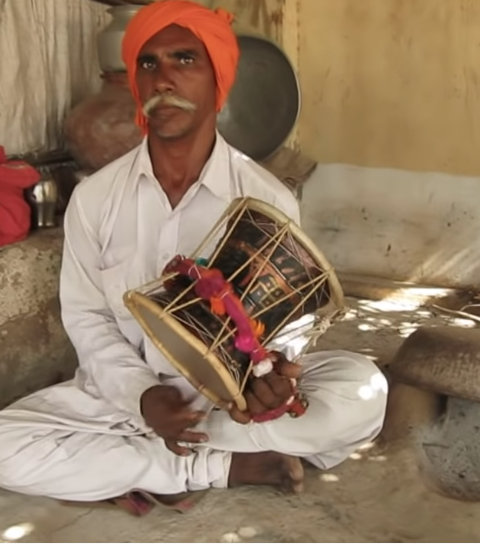
Dak or Dakla is a traditional folk instrument made from wood, with a leather drum head at both ends. Dak has been integral part of Kutch folk music for many centuries.
The instrument is made up of a hollow wooden barrel which is almost cylindrical in shape. And at both ends of the barrel is the sheep skin stretched over the mouths of the barrel and laced to the mouth’s rim with a thread.
Further, a string of thick rope runs in many rows along the length of the cylinder – in one continuous loop passing along the rim of the head in the process.
The Dak player holds the instrument by these ropes in one hand and strikes the leather head by a stick with the other hand. During the play, the musician tightens and looses his/her grip on the ropes. This tightening and loosening of the ropes, elongates and retracts the leather head.
This elongation and retraction of leather head as the musician strikes the head with the stick effects the variations in taal (tempo) and lai (rhythm).
Dak has been an integral part of Mataji temples in the Abdasa and Lakhpat regions of Kachchh for many centuries. Back then, these musicians enjoyed lots of respect in the villages they lived and were well taken care off by the village itself.
But today a Dak Musician finds it difficult to sustain on his/her music. With the modern lifestyle changes and with plenty of readily available multi-media options, folk traditions like Dak are losing their appeal among the locals.
And the Dak instrument and the player became stereotyped and limited to play only in temples. Kala Varso has been working with the Dak artists to change this perception and integrate them with mainstream Kutch Folk Music.
But this integration has been a challenge for us. As it happened, in couple of Reyans (folk music evenings in the villages), where some of the audience objected to the sounds of Dak as they feared those sounds may awaken unwanted spirits. But this also gives us an opportunity to discuss and dispel the wrong myths and notions associated with traditions or in general.
We use Reyans as a medium to not only promote local folk music traditions but also as a tool for education and knowledge transmission.